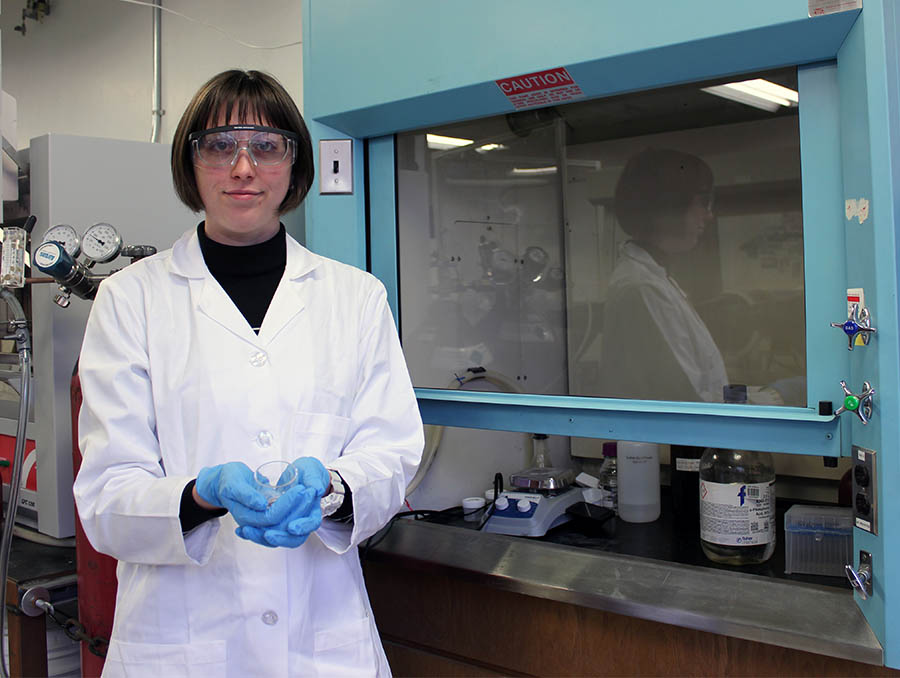When most people think about glass, windows, drinking glasses or eyewear may come to mind. But engineering grad student Harmony Werth is using it for a very different application – storage of nuclear waste. Werth is studying a new process to reduce waste and immobilize it in a chemically durable form. She is working with her advisor, Chemical & Materials Engineering Associate Professor Krista Carlson, as well as other researchers from Pacific Northwest National Laboratory.
Nuclear waste management is a field of interest for Werth, one that grew out of her interest in glass, and one that she will explore at WM Symposia’s Waste Management Conference — an annual international conference on radioactive waste management and related topics — this March in Phoenix. Last month, Werth received the Roy Post Foundation Scholarship for students interested in the safe management of nuclear materials, which will cover her expenses to the conference along with the $5,000 scholarship.
Werth is one of a handful of graduate and undergraduate students around the country to receive the Roy Post Foundation Scholarship, named after the founding chief executive of WM Symposia, a nonprofit dedicated to providing education and information exchange on global radioactive waste management.
A tour of materials
Werth, who is on track to earn her master’s in materials science and engineering this summer, originally was interested in polymers: natural or synthetic substances that are the basis of many minerals and man-made materials. As a University of Nevada, Reno undergrad studying materials science — she earned her bachelor’s degree in May 2023 — she studied a wide range of materials, from an undergraduate research experience studying the lubrication of stainless steels, to a research fellowship at the University of Idaho researching 3D-printed polymers for biomedical applications. During those experiences, Werth realized that she had an interest in the structure of materials at an atomic level, an interest that extended far beyond her initial interest in exclusively polymeric materials.
Then she took Carlson’s biomaterials course in fall 2022. Intrigued by Carlson’s research on glass science, she eventually began working in the professor’s lab as an undergraduate researcher.
“I invited Harmony to join my group because I could see that she was not just interested in getting a good grade but really wanted to understand composition-property relationships to design materials for different applications,” Carlson said.
Werth said she was fascinated by how glass is defined by its structure rather than by the materials from which it’s made. Polymers, metals and ceramics all can be induced into a glassy form in certain conditions. Such control over the atomic structure of a material allows for advanced applications that require specific properties.
Like containing nuclear waste. Currently, Werth is working in Carlson’s lab creating glass forms from various materials and studying how they immobilize radioactive waste. This process — vitrification — is seen as a suitable process for managing high level waste (HLW) arising from the reprocessing of spent fuel, according to the World Nuclear Association.
As the organization explains on its website: “Most HLW, other than spent fuel itself, arises in a liquid form from the reprocessing of spent fuel. This HLW comprises highly-radioactive fission products and some transuranic elements with long-lived radioactivity. To allow incorporation into the glass matrix the waste is initially calcined (dried) to a granular powder. The product is then incorporated into molten glass, poured into a robust stainless-steel canister about 1.3 meters high, and allowed to cool, forming a solid matrix. The containers are then welded closed and are ready for storage and final disposal.”
Werth says she hopes to work on nuclear waste vitrification upon graduation — a field that she finds fascinating with complex challenges that may be extremely beneficial to society. She is interested in how the challenges in the field require control of the glass composition and processing conditions to get a specific result. She’s also interested in the optical properties of glass, as optical properties are strongly influenced by the arrangement of atoms in the material.
Clearly, glass is at the heart — it’s the nucleus — of Werth’s current career aspirations.















